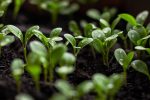Trichoderma harzianum is a species of filamentous fungus widely recognized for its beneficial properties in agriculture, horticulture, and biotechnology. Known primarily as a biological control agent, T. harzianum is used to manage plant diseases caused by pathogenic fungi, promote plant growth, and enhance soil health. It is a common species within the Trichoderma genus, which includes numerous fungi known for their antagonistic capabilities against pathogens and their ability to enhance plant resilience.
Characteristics of Trichoderma harzianum
- Taxonomy: T. harzianum belongs to the family Hypocreaceae and is commonly found in soil, decaying wood, and other organic matter.
- Morphology: The fungus has a mycelium structure composed of hyphae, with green conidia (spores) that aid in reproduction and spread. It forms colonies with a distinctive green or yellowish color, depending on environmental conditions.
- Adaptability: T. harzianum is highly resilient and can grow in a wide range of environmental conditions, including varying temperatures, pH levels, and moisture content. This adaptability is one reason it is such a successful biological control agent.
Mechanisms of Action in Biological Control
T. harzianum uses several mechanisms to inhibit pathogenic fungi, contributing to its efficacy as a biological control agent:
- Mycoparasitism: T. harzianum attacks and parasitizes pathogenic fungi by producing enzymes that degrade the cell walls of other fungi. Key enzymes include chitinases and glucanases, which break down chitin and glucans, the main structural components in many fungal cell walls.
- Antibiosis: The fungus secretes metabolites with antifungal properties, such as gliotoxin, viridin, and harzianic acid, which inhibit the growth of nearby pathogenic fungi. These compounds create an environment that is hostile to pathogens, protecting plants from infection.
- Competition: T. harzianum competes for resources such as space, nutrients, and moisture, outcompeting pathogenic fungi in the root zone and soil. This reduces the chance of pathogens establishing themselves.
- Induction of Plant Resistance: The fungus can trigger systemic resistance in plants, enhancing their natural defenses against pathogens. This effect, known as induced systemic resistance (ISR), involves signaling pathways in the plant that prime it for defense against a broad range of diseases.
Agricultural and Horticultural Applications
T. harzianum has several applications that benefit crop health and yield:
- Biological Control Agent: The fungus is widely applied as a biopesticide against various plant pathogens, including Rhizoctonia, Fusarium, Pythium, and Sclerotinia species. These pathogens cause diseases such as root rot, damping-off, and wilt, which can devastate crops. T. harzianum reduces the incidence of these diseases by directly inhibiting or outcompeting the pathogens.
- Soil Health Enhancer: By decomposing organic matter and promoting nutrient cycling, T. harzianum enriches the soil microbiome and contributes to soil health. This enhances the availability of nutrients for plants and improves soil structure.
- Growth Promotion: T. harzianum can produce growth-promoting compounds, including plant hormones like auxins, cytokinins, and gibberellins. These hormones stimulate root development, leading to better nutrient uptake, improved resilience to stress, and increased crop yield.
- Sustainable Agriculture: Using T. harzianum as a biological control agent supports sustainable agriculture by reducing reliance on chemical pesticides, which can lead to environmental contamination and pesticide resistance.
Application Methods
T. harzianum is applied to crops in several forms, depending on the crop type and target pathogen:
- Soil Treatment: The fungus can be applied directly to soil or as a seed coating to establish itself in the root zone, providing continuous protection against soil-borne pathogens.
- Foliar Spray: A liquid formulation of T. harzianum can be sprayed on leaves to protect against foliar pathogens.
- Compost Additive: Adding T. harzianum to compost enhances decomposition and suppresses pathogens in the compost, producing healthier organic matter for soil amendment.
Industrial and Biotechnological Uses
Beyond agriculture, T. harzianum is valued in various biotechnological applications:
- Enzyme Production: Its ability to produce hydrolytic enzymes, such as cellulases and xylanases, makes T. harzianum a source of enzymes used in industrial applications, including biofuel production and waste management.
- Bioremediation: The fungus is studied for its potential in bioremediation due to its capability to degrade certain pollutants, including pesticides and heavy metals, in contaminated soils.
Challenges and Considerations
While T. harzianum is a beneficial biological control agent, its use comes with certain considerations:
- Environmental Factors: The effectiveness of T. harzianum can vary depending on environmental conditions, such as temperature, humidity, and soil composition.
- Strain Selection: Different strains of T. harzianum have varying efficacy against specific pathogens, so it’s essential to select strains suited to the target pest and crop.
- Compatibility with Other Biocontrol Agents: T. harzianum may interact with other beneficial microbes in the soil, which can be beneficial but may also lead to competition, impacting overall efficacy.
T. harzianum is a versatile fungus that plays a critical role in sustainable agriculture through its ability to control pathogens, enhance soil health, and promote plant growth. Its broad range of applications, from disease control to biotechnological uses, highlights its importance in eco-friendly agricultural practices and environmental management. The continued study and application of T. harzianum hold promise for advancing biological control methods and reducing reliance on chemical pesticides.

Leave a Reply